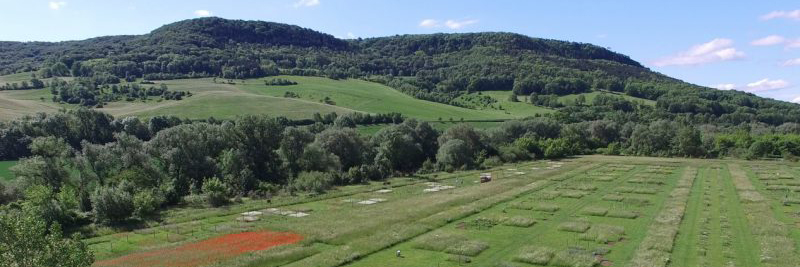We know biodiversity is vital for the functioning of ecosystems1. For plants, there is thought to be safety in numbers. In a diverse meadow, it is hypothesized that pests and diseases (antagonists) get “diluted,” while beneficial microbes (mutualists) thrive. This should, in theory, allow plants to relax, invest less in costly defenses, and focus more on growth.
But is it really that simple?
A team of researchers around Leonardo Bassi and Alexandra Weigelt from Leipzig University put this idea to the test2. In the Jena Experiment3, a 19-year-old experimental grassland in Germany, they ask some fundamental questions: Do plants in more diverse communities really lower their guard? Does this change happen differently in leaves versus roots? And does every species react in the same way? The core ecological hypothesis was that in diverse plant communities, pressure from pests decreases, allowing plants to invest less in defense. To test this, the team measured 23 defense-related traits in the leaves and fine roots of 16 different plant species. This provided an unprecedentedly detailed look at how plants adapt to life in a crowd.
The Jena Experiment is a long-term ecological study in Germany that focuses on the relationship between plant biodiversity and ecosystem functions. Established in 2002, it is one of the world’s largest and longest-running biodiversity experiments.

To answer their questions, the research team used an untargeted metabolomics workflow to investigate how plant defenses change in response to biodiversity. Using LC-MS/MS, they captured 9,551 features and used SIRIUS for feature annotation and compound class prediction, successfully classifying 5,187 features (54%). The dominant chemical classes present were shikimates and phenylpropanoids (20%), terpenoids (15%), and alkaloids (2%).
It’s a Battle for Resources, Not a Break from Pests
The study’s first and most significant discovery was that the initial hypothesis did not hold up. Most of the plant defense traits measured did not change at all with increasing plant diversity. For the few that did, the driving force was not a reduction in pests but rather a fierce competition for resources.
This competition led to a stark decoupling of defense strategies between the leaves aboveground and the roots belowground. As plant diversity increased, the leaves became physically weaker: Traits like leaf mass per area and leaf dry matter content decreased. This is likely an adaptation to compete for light in a denser canopy, creating thinner, more efficient leaves for light capture. At the same time, roots became physically tougher: Root dry matter content increased and root nitrogen content decreased. This suggests roots were adopting a more conservative, robust strategy, likely in response to increased competition for scarce nutrients and water in the soil.
This finding suggests changes in resource availability—light above, nutrients below—are the primary drivers of plant strategy in diverse communities, which in turn may influence the pressure from pests, and not the other way around.
Physical Defense Down, Chemical Defense Up
As their physical defenses weakened, plants appeared to compensate by increasing their chemical arsenal. The untargeted metabolomics analysis revealed a trend towards increased production of defensive chemical compounds in the terpenoid and shikimate/phenylpropanoid pathways. This suggests plants were compensating for weaker physical structure with a more potent chemical arsenal. By grouping the compounds into major defense pathways, they could see subtle but important shifts in chemical strategy.
Species-specific Responses in Chemical defense traits
Some responses were highly species-specific. This was most common in chemical defense traits and in traits related to collaboration with mutualists, like mycorrhizal fungi. For example, the grass Trisetum flavescens significantly increased its number of leaf terpenoids and its colonization by mycorrhizal fungi in more diverse plots, while other species did not. The production of alkaloids in roots also varied, increasing in some species and decreasing in others as diversity changed. This suggests that while resource competition sets the main stage, the dilution of specific pests or accumulation of helpful microbes might still be happening, but it affects each plant species differently.
What This Means for Ecology
This research provides a nuanced view of how biodiversity shapes plant communities. It highlights that we cannot understand plant strategies by looking at just leaves or roots in isolation; we need to see the whole picture. The key takeaway is that competition for resources seems to be a more powerful and consistent force than pest pressure in shaping how plants adapt to diverse environments.
The battle for light and nutrients forces plants into a complex balancing act, leading to opposite strategies above and below the ground. This, in turn, creates the conditions that herbivores and pathogens experience. Ultimately, the study shows that the intricate dance between plants, their neighbors, and their enemies is less a simple story of “safety in numbers” and more a complex tale of trade-offs driven by the fundamental need for resources.
References
- Cardinale BJ, Duffy JE, Gonzalez A, Hooper DU, Perrings C, Venail P, Narwani A, Mace GM, Tilman D, Wardle DA, Kinzig AP, Daily GC, Loreau M, Grace JB, Larigauderie A, Srivastava DS, Naeem S. Biodiversity loss and its impact on humanity. Nature. 2012 Jun 6;486(7401):59-67. https://doi.org/10.1038/nature11148 ↩︎
- Bassi L, Hennecke J, Albracht C, Solbach MD, Rai A, Pinheiro Alves de Souza Y, Fox A, Zeng M, Döll S, Doan VC, Richter R, Kahl A, Von Sivers L, Winkler L, Eisenhauer N, Meyer ST, van Dam NM, Weigelt A. Plant species richness promotes the decoupling of leaf and root defence traits while species-specific responses in physical and chemical defences are rare. New Phytol. 2025 Apr;246(2):729-746. https://doi.org/10.1111/nph.20434 ↩︎
- Christiane Roscher, Jens Schumacher, Jussi Baade, Wolfgang Wilcke, Gerd Gleixner, Wolfgang W. Weisser, Bernhard Schmid, Ernst-Detlef Schulze. The role of biodiversity for element cycling and trophic interactions: an experimental approach in a grassland community. Basic and Applied Ecology 5(2), 2004, 107-121. https://doi.org/10.1078/1439-1791-00216 ↩︎





